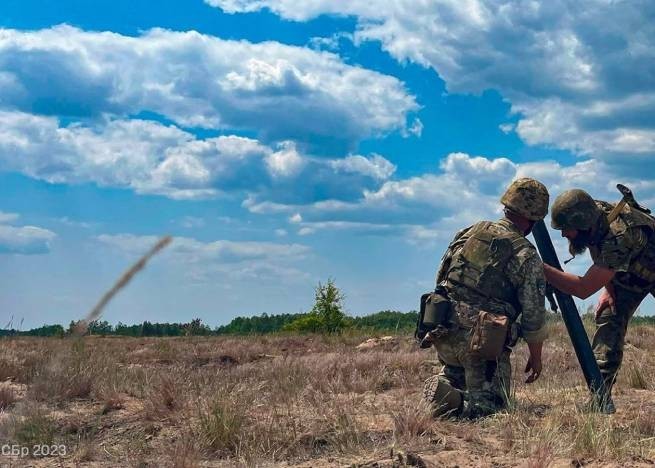Detailed and impartial information about what is happening now in Ukraine. Summary for the week from June 16 to June 22.
About the latest events tells telegram channel “Volya”, accompanying the information with analytical conclusions.
Last week, the Russian Armed Forces dropped on the Central Hospital in the village of Liptsy (Kharkiv region) heavy aerial bomb FAB-3000 with UMPC module. Such a bomb contains up to 1200 kg of explosives; it was created to destroy fortified firing points or concrete fortifications. The bomb exploded 10 meters from the building in which Ukrainian Armed Forces servicemen were located. The house has stood, and there are dead and wounded among the Ukrainian military.
The Russians hastened to declare the FAB-3000 a new superweapon capable of turning the tide of the war and helping to quickly overcome Ukrainian defenses. However in practice, it is only a powerful aerial bomb that can cause great destruction if it hits the target accurately, but accurate hits are precisely the problem. As Ukrainian soldiers and officers say, who have repeatedly been under Russian bombs of varying power, it is loud and scary, but these bombs do not have a destructive effect.
In the direction of Liptsov Russian troops for about two weeks defend rather than attack. Near Volchansk The Russian Armed Forces continue daily assaults in the city and to the west. The Ukrainian Armed Forces are conducting counterattacks in Volchansk itself; during one of these counterattacks, Ukrainian soldiers drove the Russians out of Gorky Park and cut off supplies to the assault group of the Russian Armed Forces, entrenched at the Aggregate Plant.
The group at the plant consists of up to two infantry platoons. For several days they tried to get reinforcements and supplies, but so far these attempts have failed rather than succeeded. The Russians deliver supplies to the plant using drones.
Group of Forces “North” is experiencing big problems with supplying the offensive operation in the Kharkov region. In addition, they lack manpower. Reinforcements are not being given in this direction, and the forces available to the “northerners” cannot achieve decisive successes in Volchansk. At the headquarters of the GV “North” they speak carefully about a possible withdrawal if the situation with supplies or reinforcements does not change. If the withdrawal is not agreed upon, the captured bridgeheads in the Kharkov region will become a constant source of losses and problems.
The situation in the Kupyansky direction
Here, Russian troops have a significant numerical advantage in people, equipment and artillery (the Russian Armed Forces have an advantage in aviation so far in all sectors of the front, except for the Kherson region). The Armed Forces of Ukraine are defending themselves on a wide front with the help of several brigades, which have not left the battle for more than a month. Moreover, a large area is protected by units of only one of these brigades.
Despite the advantage, the RF Armed Forces have not yet been able to achieve either significant breakthroughs or major advances forward. The losses of Russian troops in the Kupyansk direction remain high, and to maintain the intensity of the offensive, reinforcements are being transferred here from the Zaporozhye Front, from Lugansk and the Rostov region.
In the Kupyansk direction, the Russian Armed Forces have gathered up to 72 thousand people, of which up to half take part directly in hostilities.
Chasov Yar
Fighting continues in the city, the Ukrainian Armed Forces hold the western and northern outskirts of the Kanal microdistrict, and the Russians are throwing all their strength into breaking through the urban development. Attempts by Russian troops to advance north of Chasov Yar and south of the city have not yet been successful. Both sides are suffering constant losses, but the Russian Armed Forces have lost too many people from the air assault brigades, which they are trying to replace with mobilized ones, BARS and motorized rifles. Reinforcements from the Rostov region and the Zaporozhye Front are also sent to Chasov Yar. The Ukrainian Armed Forces are holding on with the same forces that were in the area.
In Kleshcheevka and Andreevka, Ukrainian troops improved their positions, for example, in Kleshcheevka, the Ukrainian Armed Forces now control part of the destroyed village, and not just the heights to the west. In Andreevka, the Russian Armed Forces are conducting regular assaults, but without any results other than losses.
The Russian Armed Forces attacked New York
The offensive in the new direction, which the Russian military told us about back in April-May, has finally begun. At the beginning of the week, the Russian Armed Forces launched precise artillery strikes on the positions of the Ukrainian Armed Forces east of Toretsk and New York, with the support of tanks and armored vehicles, they advanced forward and occupied the village of Shumy and several Ukrainian positions on the front line.
This offensive had been planned for a long time; since April, the Russian Armed Forces had been forming a strike group, which numbered up to 15 thousand people, but was then torn apart by reinforcements near Ocheretino and Chasov Yar. As a result, the offensive was launched by five brigades (about 10 thousand people).
The objectives are to capture Toretsk and New York, force Ukrainian units to leave their positions at Alexandropol, and then develop an offensive to the north to reach Konstantinovka (south of Kramatorsk) and force the Ukrainians to retreat from Kleshcheevka and Andreevka under the threat of encirclement. So far, the Russian Armed Forces have achieved tactical success in this direction and can reach Toretsk in the coming days.
The Ukrainian Armed Forces also knew about the preparations for this offensive, so it certainly did not come as a surprise. The question is what the Ukrainian reaction will be and how far the Russians will be allowed to advance in this direction.
Alexander Syrsky diligently protects reserves, so in this area the Armed Forces of Ukraine have to make do with the forces that are there. In the Toretsk area, the line of contact has not moved since 2022; this area was considered relatively calm until the fall of 2023, when the Ukrainian Armed Forces conducted several operations here against Russian troops in Gorlovka.
Pokrovskoe direction
On the evening of June 21 and the morning of June 22, the Russian Armed Forces carried out several attacks to the west from Novoaleksandrovka and were able to advance 1.5-2 km. Also, Russian units were able to move about 500 meters north of Novoaleksandrovka towards Vozdvizhenka. The goals of the Russians are still the same: to cut the Pokrovsk-Kramatorsk highway, to push the Ukrainian Armed Forces west of the Karpov Reservoir. This area remains one of the main devourers of Russian reserves and a generator of losses. Last week, several units were even transferred here from the Dnepr Main Guard, which already cannot boast of an abundance of personnel and combat-ready units.
The Pokrovsky direction can be considered the most successful section of the Russian spring-summer offensive. The command of the Russian Armed Forces group in Ukraine perceives it this way, and therefore does not spare reserves. Here, from Georgievka in the south to Novoaleksandrovka in the north, up to 48 thousand people are concentrated directly at the front line, and up to 22 thousand more in the immediate rear. All these forces were thrown into solving the problem of reaching Malinovka and cutting the route from Pokrovsk to Konstantinovka-Kramatorsk.
The situation in the Ugledar direction
In the Ugledar area, the Russian Armed Forces continue to storm forest plantations east of Konstantinovka, fighting in the gullies towards the village of Vodyanoye and the road passing through it. A few days ago, the Russian Armed Forces resumed attacks from Staromayorsky, but with small forces and so far without results.
The Ugledar direction, according to Russian staff officers, is considered promising, the group’s command expects to cut off the supply to Ugledar by mid-summer, and by August to achieve at least a semi-encirclement of the Ukrainian Armed Forces in this area. Therefore, the few Russian reserves are being pulled here too.
While the shortage of people is not visible on the front line, it is already being felt by some staff officers, who are increasingly vocal that the Russian Armed Forces are paying too high a price for moderate successes in the summer offensive. And in the second half of the summer, this could lead to unpredictable consequences if it turns out that the Ukrainian Armed Forces still has large reserves and risks launching a counterattack in some of the areas (perhaps not even the most active one now).
The authorities call such officers alarmists and do not take their warnings seriously. However, there are almost no people willing to report such things to the top. Two years of war taught officers to remain silent.
Will/Volya. Maps with the situation on the fronts can be viewed Here.







More Stories
Negotiations between Russia and Ukraine on prisoner exchange
Ukrainian Armed Forces bomb Russian territory for the first time with French guided bombs
Critics of the authorities are under arms. Kyiv has found an effective way to deal with unwanted